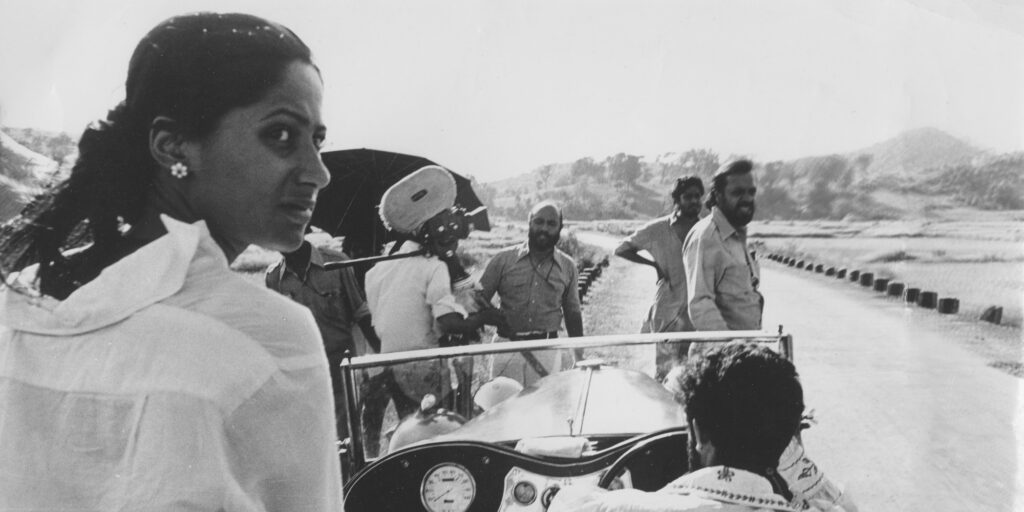Rebellious Poets and Radical Spirits: Indian Parallel Cinema

Curated by Shivendra Singh Dungarpur, Cecilia Cenciarelli and Omar Ahmed
What is Parallel Cinema? Even after 50 years it is a question that remains open to debate. Was it a movement, a genre, a revolution, a new approach to making films? Often misused as a label for unconventional and experimental cinema or simply in opposition to mainstream or populist cinema, Parallel Cinema is a complex, rich and vast phenomenon to define. Its genesis is rooted in the theoretical Manifesto of the New Cinema Movement published in 1968 by filmmakers Arun Kaul and Mrinal Sen. The following year, an unconventional triptych of films was released – Mrinal Sen’s Bhuvan Shome, Mani Kaul’s Uski Roti, Basu Chatterjee’s Sara Akash – marking the beginning of one of the most creative and radical juncture in Indian cinema. All three films were produced by the nascent Film Finance Corporation (set up by the state to provide low-interest loans for production) which would play a key role in the shaping and future transformations of Parallel Cinema. Our strand looks at its foundational years (1968-1976) characterised by multiple creative streams and flowing in many directions, absorbing the cinematic influence of the European new waves as well as the aesthetic and leftist political ideology of Bengali cinema.
Thanks to curators and archivists around the globe, the strand has offered the chance to map where exactly and in what state Parallel Cinema films exist, opening a door for further archival and actual restoration work. This strand would have not been possible without the generosity and unflagging enthusiasm of Shivendra Singh Dungarpur, who travelled between lockdowns to check all elements in person.
We are excited to be screening films such as Bhuvan Shome (1969), Maya Darpan (1972), Ghatashraddha (1977) and Kummatty (1979), unconventional works that symbolise the radical spirit of Parallel Cinema. The work of visual poets Govindan Aravindan and Kumar Shahani has rarely been screened publicly, and we wish to recognise their significant aesthetic and intellectual contributions to Parallel Cinema, along with the other filmmakers in this strand. Our selection, necessarily a partial one, narrates an eclectic story in which many filmmakers made films in their regional languages. Adoor Gopalakrishnan, G. Aravindan and John Abraham, for instance, created a new idiom in Malayalam cinema; Goutam Ghose, Buddhadeb Dasgupta and Aparna Sen changed the face of Bengali cinema; Girish Kasaravalli, Girish Karnad and B.V. Karanth in Kannada films etc. We are optimistic this strand is the beginning of a new journey for Indian Parallel Cinema, a defining part of global film history that merits its place alongside iconic moments such as Italian Neorealism, The French New Wave, New German Cinema and Cinema Novo.
Sincere thanks to Kiran Dhiwar, Mike Mashon and Jon Shibata for their precious contribution.
Omar Ahmed and Cecilia Cenciarelli
As I sit down to pen my thoughts on Parallel Cinema in India, I remember the memorable conversations I have had over the years with many of the filmmakers who were at the forefront of a movement that broke the mould. Among these, Kumar Shahani’s reminiscences about being a student of Ritwik Ghatak at the Film and Television Institute of India in Pune, and how their sessions under the ‘Wisdom Tree’ deeply shaped his vision, have stayed with me. Shahani made an extraordinary avant-garde graduation film, The Glass Pane (1966). Mrinal Sen was also among his teachers and he said about the film, “I loved the classroom exercise… for venturing to shoot in adverse conditions. In 1968, when I got a loan from the then Film Finance Corporation I formed a team, almost all having little or no ‘commercial’ content but with an abundance of verve and courage. I asked K.K. Mahajan if he would do the photography as a sort of love’s labour, so to say. K.K. readily accepted.” This link between The Glass Pane and Mrinal Sen’s Bhuvan Shome set in motion a chain reaction that became an artistic revolution.
Having made CzechMate – In Search of Jiří Menzel, a film on the Czechoslovakian New Wave movement, a short-lived but artistically powerful movement that germinated from FAMU – the film school in Prague and was funded by the government – I cannot help but see the analogy. One of the key influences of India’s Parallel Cinema was the unique synergy between filmmakers and archivists as teachers.
While Ritwik Ghatak’s teachings on the grammar and art of cinema had a powerful influence on his students, which included Kumar Shahani, Mani Kaul and John Abraham, to name a few, encouraging them to break the bounds of conventional filmmaking, it was archivist P.K. Nair, founder in 1964 of the National Film Archive of India, who begged, borrowed and even stole to ensure that the students had the rare opportunity to watch the films of Alexander Dovzhenko, Luis Buñuel, Andrei Tarkovsky e Sergei Parajanov. There’s a famous story of John Abraham knocking on P.K. Nair’s door in the dead of night demanding that Pasolini’s The Gospel According to St. Matthew be screened for him right away… And so it was! Mr. Nair of course went on to influence generations of Indian filmmakers, something I know from personal experience, having been a student of FTII myself. But none of them matched the radical poets and rebels of the Parallel Cinema movement: inspired by the work of their precursors Satyajit Ray, Ritwik Ghatak and Mrinal Sen, they revolutionised Indian cinema. They were a rebellious collective of individual auteurs and it is time that their immense artistic legacy is cherished and revived.
Shivendra Singh Dungarpur
Program
BHUMIKA
BHUMIKA
GHATASHRADDHA
GHATASHRADDHA
KUMMATTY
KUMMATTY
BHUVAN SHOME
BHUVAN SHOME
USKI ROTI
USKI ROTI
ELIPPATHAYAM
ELIPPATHAYAM
KHAYAL GATHA
KHAYAL GATHA
AMMA ARIYAN
AMMA ARIYAN
MAYA DARPAN


